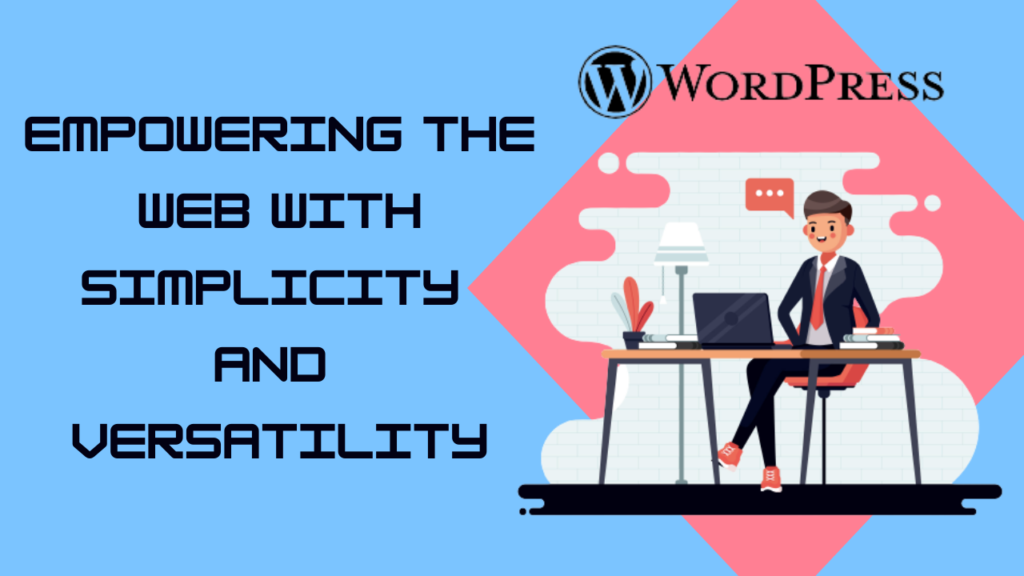What is WordPress – Empowering the Web with Simplicity and Versatility
In the ever-evolving landscape of the internet, content creation and management have become paramount. Websites serve as digital storefronts, interactive platforms, and information hubs. This demands a user friendly, efficient, and versatile content management system (CMS) that can cater to the needs of both beginners and experienced users. One such tool that has revolutionized the way websites are built and managed is WordPress.
Understanding What is WordPress
WordPress is an opensource CMS that was first introduced in 2003 as a blogging platform. Over the years, it has transformed into a comprehensive website building tool used by millions around the globe. The beauty of WordPress lies in its simplicity and adaptability. Users of all skill levels, from novices to seasoned developers, can leverage its features to create websites ranging from personal blogs to professional portfolios, ecommerce stores, and corporate websites.

Key Features of WordPress
1. User Friendly Interface: WordPress offers an intuitive dashboard that allows users to manage their websites with ease. The interface is designed to be user friendly, enabling users to update content, upload media, and customize the appearance of their websites without requiring extensive technical knowledge.
2. Customization Options: With thousands of themes and plugins available, WordPress offers unparalleled customization options. Themes determine the visual design of the website, while plugins add functionality such as contact forms, ecommerce capabilities, social media integration, and more.
3. SEO Friendly: WordPress is inherently designed to be search engine friendly. It generates clean and organized code, making it easier for search engines to crawl and index the content. Additionally, there are plugins like Yoast SEO that assist users in optimizing their content for better search engine rankings.
4. Scalability: Whether you’re starting with a simple blog or building a complex ecommerce platform, WordPress can scale to meet your needs. Its modular architecture ensures that your website can evolve as your business or project grows.
5. Community and Support: Being opensource, WordPress benefits from a vast and active community of developers, designers, and users. This community contributes to the improvement of the platform, develops themes and plugins, and provides extensive support through forums and documentation.
Setting Up WordPress: A Step-by-Step Guide
Setting up WordPress is a straightforward process that can be completed in a few simple steps. Whether you’re a first-time user or a seasoned developer, these steps will guide you through the process of setting up your own WordPress powered website.
Step 1: Choose a Domain Name and Hosting Provider
1. Choose a Domain Name: Your domain name is your website’s address on the internet. Choose a name that represents your brand or content and is easy to remember.
2. Select a Hosting Provider: Web hosting is where your website’s files will be stored. Choose a reputable hosting provider that offers good performance, customer support, and suitable hosting plans for your needs.
Step 2: Install WordPress
1. Manual Installation:
Download the latest version of WordPress from the official website.
Upload the files to your hosting server using FTP or the hosting provider’s file manager.
Create a MySQL database and user through your hosting control panel.
Run the WordPress installation script and follow the prompts to connect to the database.
2. OneClick Installation:
Many hosting providers offer one click installation of WordPress through their control panel (e.g., cPanel). This simplifies the process significantly.
Step 3: Configure Basic Settings
1. Login to the WordPress Dashboard: Access your website’s dashboard by adding “/wpadmin” to your domain (e.g., www.yourdomain.com/wpadmin).
2. General Settings:
Set your site’s title and tagline.
Choose your preferred time zone.
Step 4: Choose and Customize a Theme
1. Access the Theme Menu:
In the dashboard, go to “Appearance” and then “Themes.”
2. Add a New Theme:
Click “Add New” to browse and search for themes.
Install and activate the desired theme.
3. Customize the Theme:
Most themes offer customization options through the “Customize” option.
You can change colors, fonts, layout, and more to match your branding.
Step 5: Install Essential Plugins
1. Access the Plugins Menu:
In the dashboard, go to “Plugins” and then “Add New.”
2. Search and Install Plugins:
Search for essential plugins such as “Yoast SEO” for SEO optimization, “Contact Form 7” for forms, and “WooCommerce” for ecommerce functionality.
Install and activate the plugins.
Step 6: Create Essential Pages
1. Add New Pages:
In the dashboard, navigate to “Pages” and click “Add New.”
2. Create Key Pages:
Create essential pages like “Home,” “About Us,” “Contact,” and any other pages relevant to your website.
Step 7: Customize Your Website Content
1. Add Posts:
For a blog or news section, create and publish posts.
Add categories and tags to organize your content.
2. Add Media:
Upload images, videos, and other media to your media library.
Insert media into your pages and posts.
Step 8: Configure Additional Settings
1. Permalinks:
Go to “Settings” and then “Permalinks.”
Choose a permalink structure that is SEO friendly.
2. Reading Settings:
Determine whether you want a static front page or a list of recent posts on your homepage.
Step 9: Secure Your Website
1. Update Regularly:
Keep WordPress, themes, and plugins updated to ensure security.
2. Use Strong Passwords:
Set strong passwords for your WordPress account and hosting.
3. Install Security Plugins:
Consider using security plugins to enhance your website’s security.
Step 10: Launch Your Website
1. Double Check Everything:
Review your website’s content, design, and functionality.
2. Announce Your Launch:
Share your website on social media and with your network.
WordPress has transformed the way websites are created and managed. Its user-friendly interface, customization options, and vibrant community make it an ideal choice for individuals, businesses, and organizations seeking a versatile online presence. By following the step-by-step guide above, you can set up your own WordPress website and join the millions of users who are leveraging this powerful platform to bring their online visions to life.
Other Resources:
- Travel Blog Post Ideas – Exploring the World Through Words.
- WordPress.com vs WordPress.org – A Comprehensive Comparison.
- Propeller Ads – Popular Online Advertising and Monetization.
- SEO – Your Pathway to Online Success.
- Unleashing the Power of SEMrush (A Comprehensive Guide).
- How to Use Pinterest for Blogging.
- Hostinger Review in 2023.
- SiteGround Review in 2023.
- The Best Blog Writing Tools.
- How to Make Your Blog Posts Go Viral.
- How to Get Your Blog Up and Running in 7 Easy Steps.
- How To Make Money with Affiliate Marketing for Beginners in 2023.
- 5 Practical Things To Do After Starting A Blog.
- Social Media Promotion.
- Pick A Profitable Niche In 5 Minutes.
- Best Niches for Affiliate Marketing in 2023.
- 10 Tips for Creating Engaging Blog Posts.


